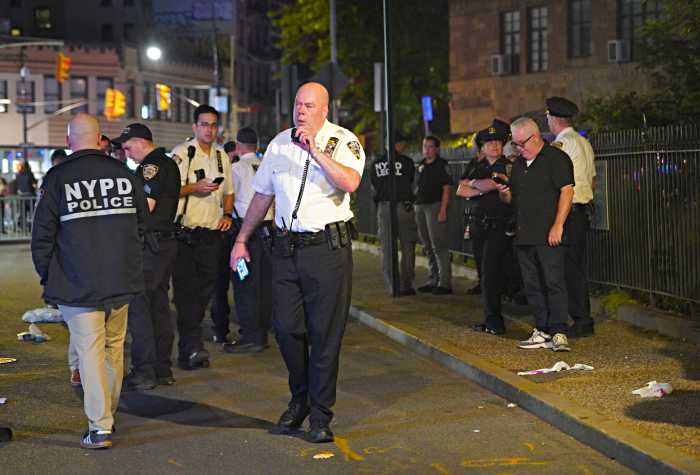With more than 200 million cell phone users in the United States, more and more people need to stay connected, which means that cell phone companies need to provide reliable coverage.
This blanket coverage is achieved primarily through cell phone towers (free-standing 80 to 120 foot-tall structures) and antennas (four to five feet in height and affixed to buildings) that receive and transmit radiofrequency (RF) signals.
It seems that the city’s buildings are dotted with endless cell antennas while the larger, harder to disguise cellular towers are not always welcome anywhere in the city.
“We don’t know enough about cell antennas,” said Councilman Peter Vallone Jr. at a rally last week. “We can’t use our children as guinea pigs in this ongoing technological experiment.”
Vallone, along with Councilman Tony Avella, parents and community leaders gathered outside St. Mel’s School in Flushing on Thursday February 16 to protest the 23 cell phone antennas that were quietly mounted on the roof of the school and generate approximately $56,000 in annual contracts.
“We’re very concerned about the ill effects of cell antennas on children,” said Valerie Cercone, who lives nearby and whose niece and nephew attend St. Mel’s. Many echoed the sentiment, stating that if the antennas are not taken down, they will remove their children from the school.
“If the antennas don’t come down, my kids are coming out,” said Josephine [no last name given].
“I understand their concern for the safety of their children,” said Father Christopher Turczany, pastor of St. Mel’s, which has an enrollment of 550.
According to the Diocese of Brooklyn, 28 Catholic schools have cellular antennas on their roofs. The technology was banned from public schools in 2003 by the Panel for Education Policy.
But experts in the field claim that cellular antennas are safe and point out that 5,000 911 calls were logged from cell phones in the area between January 1 and February 15.
“In order to have service the only way to maintain wireless communication is through towers and antennas,” said Joe Farren, director of public affairs for CTIA, The Wireless Association, an industry trade group out of Washington, DC. “There is no evidence of adverse health effects,” he said.
“We transmit under FCC [Federal Communications Commission] regulations,” said Russ Stromberg, northeast region director of development for T-Mobile, whose six antennas have been on St. Mel’s since 2000. “Radio waves from antennas go out horizontally in a straight line and fall off exponentially within feet. It’s impossible for it to carry enough energy to do any damage.”
At the request of The Queens Courier and to prove that the antennas on St. Mel’s School are, in fact, safe, Stromberg arranged to have representatives of Pinnacle Telecom Group, LLC, a consulting and engineering firm for the Telecommunications Industry, visit the school and do an on-site inspection.
Daniel J. Collins, chief technical officer for Pinnacle used Narda, a state-of-the-art piece of equipment that registers radio waves and converts the measurement to the FCC safety scale. Collins explained that antennas, much like other everyday items, can translate energy into heat, and that, to be considered dangerous, there must be a one degree increase in temperature. A cellular antenna generates measurable heat similar to a 100-watt light bulb.
He further explained that the antennas generate 20 watts of power per channel and each averages between 4 and 12 channels.
According to Collins, the FCC regulates air space between 30 megahertz and 300 megahertz, with most FM radio broadcasts occurring at 100 megahertz, and cellular antennas operating between visible light and FM radio.
The American Cancer Society (ACS) explains on its website that “cellular phones operate at the radiofrequency (RF) part of the electromagnetic spectrum. This is non-ionizing radiation. Other examples of the non-ionizing part of the electromagnetic spectrum include AM and FM radio waves, microwaves, and infrared waves from heat lamps.”
“Radio waves have too little energy to break the bonds that hold molecules (such as DNA) in cells together. Similarly, since RF of this frequency contains relatively low energy, it does not enter tissues.
Public exposure to radio waves from cellular phone antennas is slight for several reasons. The power levels are relatively low, the antennas are mounted at high above ground level, and the signals are transmitted intermittently, rather than constantly,” according to ACS.
Additionally, as the cellular signal travels through floors and ceilings, it loses 90 percent of its radiation.
When measurements inside the three-story school were taken, it was found that levels were between 0 and 0.2 percent in the hallway, with up to 100 percent still deemed safe.
In a third-floor eighth grade classroom located directly below the antennas, measurements were 0, and in the library, which is both directly across from the equipment and beneath the antennas, Narda still read 0.
According to the ACS, “if an antenna is mounted on the side of a building, the exposure level in the room directly behind the wall is typically well below the recommended exposure limits.”
However, measurements directly in front of the antennas registered at 34 percent on the safety scale.
“As I explained in the Land Use Committee meeting in November, in order to be in an area considered a safety hazard, you would have to crawl inside the antenna,” said Collins. “This is one of the well-designed sites. All of the antennas are high and facing off the roof.”
Despite the ACS’s assertion that “there is no evidence in published scientific reports that cell phone towers cause any other health problems,” Vallone is sponsoring legislation that would give both the City Council and the public some meaningful input regarding the placement of cellular antennas in residential areas, by requiring a special permit to be granted by the City Planning Commission. Under the City Charter this permit would require both a Community Board review and give the Council the power to assert jurisdiction by calling it up for a review.
In recent months, Vallone has also sponsored Intro 149, which requires the Commissioner of Buildings to maintain a list of permits issued for all antennas, and Resolution 88 (passed by the City Council), which maintains that questions regarding potential long-term health risks be addressed through a city study.
“The irony is that if you want your cell phone to be safe you need an antenna nearby,” said Stromberg. “Resolution 88 is a responsible thing and we support it.”
Regulations for cell phone antennas
Local law requires that the Department of Buildings (DOB) maintain records of the issuance of cellular antenna permits effective July 5, 2005. Since that date, the DOB has issued 294 permits.
Here are a few of the regulations regarding antennas:































